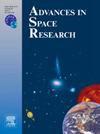运动空间目标检测的多帧时空注意运动自适应网络
IF 2.8
3区 地球科学
Q2 ASTRONOMY & ASTROPHYSICS
引用次数: 0
摘要
基于光学观测的空间目标探测是空间态势感知的基本途径。然而,在基于地面的光学图像中,空间目标通常与恒星相似,这使得单帧区分具有挑战性。密集的高动态范围恒星背景使目标提取变得更加复杂。在现实场景中,物体和观测平台之间的相对运动变化会导致不同的视速度、尺度和形状,这对现有方法有效利用多帧运动线索提出了挑战,从而限制了检测性能。为了解决这些挑战,我们提出了用于复杂背景下鲁棒小运动目标检测的多帧时空注意运动自适应网络(MSAMNet)。MSAMNet集成了自适应注意特征增强(AAFE)和时空动态运动感知(STDMA)模块来增强时空特征表示。AAFE根据信道差异和局部特征分布生成注意图,以抑制噪声并突出显示目标细节。STDMA通过指数衰减加权和多尺度异构核卷积捕获连续帧的运动特征,提高了对不同运动模式的灵敏度。此外,我们引入了BUAA-MSOD,这是第一个真实场景中多个运动空间物体的开源数据集,涵盖了不同的运动模式和目标形态,包括掩码和点级注释。实验结果表明,MSAMNet在BUAA-MSOD上显著优于当前最先进的方法,在各种空间目标上实现了更高的检测精度和更低的误报率。本文章由计算机程序翻译,如有差异,请以英文原文为准。
Multiframe spatio-temporal attention motion-adaptive network for moving space target detection
Space target detection based on optical observations is a fundamental approach for space situational awareness. However, in ground-based optical images, space targets often resemble stars, making single-frame differentiation challenging. The dense stellar background with high dynamic range further complicates object extraction. In real-world scenarios, varying relative motion between objects and the observation platform induces diverse apparent speeds, scales, and shapes, posing challenges for existing methods to exploit multiframe motion cues effectively, thereby limiting detection performance. To address these challenges, we propose the Multiframe Spatio-temporal Attention Motion-adaptive Network (MSAMNet) for robust small moving target detection in complex backgrounds. MSAMNet integrates Adaptive Attention Feature Enhancement (AAFE) and Spatio-Temporal Dynamic Motion-Aware (STDMA) modules to enhance spatio-temporal feature representation. AAFE generates attention maps based on channel-wise differences and local feature distributions to suppress noise and highlight target details. STDMA captures motion features across consecutive frames through exponential decay weighting and multi-scale heterogeneous kernel convolution, improving sensitivity to diverse motion patterns. Furthermore, we introduce BUAA-MSOD, the first open-source dataset of multiple moving space objects in real-world scenarios, covering diverse motion patterns and target morphologies with both mask and point-level annotations. Experimental results demonstrate that MSAMNet significantly outperforms state-of-the-art methods on BUAA-MSOD, achieving higher detection accuracy and lower false alarm rates across various space targets.
求助全文
通过发布文献求助,成功后即可免费获取论文全文。
去求助
来源期刊

Advances in Space Research
地学天文-地球科学综合
CiteScore
5.20
自引率
11.50%
发文量
800
审稿时长
5.8 months
期刊介绍:
The COSPAR publication Advances in Space Research (ASR) is an open journal covering all areas of space research including: space studies of the Earth''s surface, meteorology, climate, the Earth-Moon system, planets and small bodies of the solar system, upper atmospheres, ionospheres and magnetospheres of the Earth and planets including reference atmospheres, space plasmas in the solar system, astrophysics from space, materials sciences in space, fundamental physics in space, space debris, space weather, Earth observations of space phenomena, etc.
NB: Please note that manuscripts related to life sciences as related to space are no more accepted for submission to Advances in Space Research. Such manuscripts should now be submitted to the new COSPAR Journal Life Sciences in Space Research (LSSR).
All submissions are reviewed by two scientists in the field. COSPAR is an interdisciplinary scientific organization concerned with the progress of space research on an international scale. Operating under the rules of ICSU, COSPAR ignores political considerations and considers all questions solely from the scientific viewpoint.
 求助内容:
求助内容: 应助结果提醒方式:
应助结果提醒方式:


